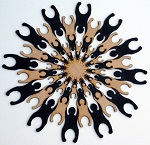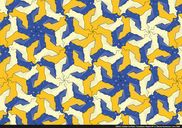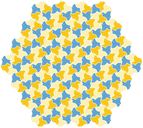|
Size: 176
Comment:
|
← Revision 138 as of 2017-11-13 12:25:36 ⇥
Size: 8916
Comment:
|
| Deletions are marked like this. | Additions are marked like this. |
| Line 1: | Line 1: |
| Post Office Manager Bredeson from Guelph, enjoys four, hobbies that make money and collecting artwork. Did a cruise ship experience that consisted of passing by Choirokoitia. | #format wiki #language en #pragma section-numbers 2 = Golden Ratio and Generative Arts = <<TableOfContents>> == Learning objectives == Your competency area Math, Data and Computation will make a quantum leap and you have an opportunity to create aesthetic qualities to be proud of. These are the evaluation criteria: [[attachment:DBM150_rubrics.xlsx]] == Learning activities == Golden Ratio refers to the number 1.618033989... used by architects, painters and designers for centuries. It occurs frequently in what nature has designed for us. In an early version of our module we studied these phenomena, see for example the beautiful movie ##<<YouTube(dveCtFPEKVs)>> https://www.youtube.com/watch?v=_w19BTB5ino At present we are ready to move much further than a simple ratio and explore relations between beauty and geometry, between aesthetics and mathematics. In this elective we create patterns and symmetries, very much like Escher did. But we shall avail ourselves of powerful tools such as matrix algebra and Processing libraries for Turtle Graphics, Vectors and Mesh diagrams, next to the Speedy 300 laser cutter at d.search labs and the computerised Brother embroidery machine at Wearable Senses. What we can achieve with such tools applied to colored wood or plastic such as [[attachment:lankveld.jpg|{{attachment:lankveldthumb.jpg|attachment:lankveld.jpg}}]] and [[attachment:kersteman.jpg|{{attachment:kerstemanthumb.jpg|attachment:kersteman.jpg}}]] and [[attachment:mattheijssen2.jpg|{{attachment:mattheijssen2nthumb.jpg|attachment:mattheijssen2.jpg}}]] Get inspired by contributions by others and us at the online Bridges mathematical art exhibition. * http://gallery.bridgesmathart.org/exhibitions/2015-Bridges-Conference * http://gallery.bridgesmathart.org/exhibitions/2015-bridges-conference/feijs But if you want, we could go further, perhaps explore fractals, cell structures, or connect to fashion, see for example * http://gallery.bridgesmathart.org/exhibitions/2014-bridges-conference/feijs Professor Loe Feijs and Dr. Jun Hu and Dr. Mathias Funk will be your guides. * Paper turtles for tessellations: http://www.drhu.eu/publications/2013-bridges-TurtlesForTessellations.pdf * Paper (with Christoph Bartneck) teaching geometric principles: http://www.bartneck.de/publications/2009/teachingGeometryDesignStudents/bartneckDCE2009.pdf Chet Bangaru and wearable-senses staff will support us. == Schedule == * Running now (DBM150) start at november 14, LG1.105, 13:45, content similar to previous year. Content and messages now via Canvas. * Completed (DGM211) * [[/201609]] * [[/201602]] * [[/201504]] * [[/201311]] * [[/201209]] * [[/201205]] == List of available reference and background materials == * Website: Official M.C.Escher website, http://www.mcescher.com/ * Book: Heesch und Kienzle, Flachenschluss,Springer-Verlag, 1963, http://www.idemployee.id.tue.nl/l.m.g.feijs/flachenschluss.pdf, or a PDF version (password protected): [[attachment:flachenschluss.pdf]] * Book: Fejes Toth, Regular Figures, Pergamon Press 1964, http://www.idemployee.id.tue.nl/l.m.g.feijs/regular-figures.pdf, or a PDF version (password protected): [[attachment:regular-figures.pdf]] * Software: Processing http://processing.org/ * Tutorial: The golden ratio course, Bartneck and Feijs, TU/e 2008, http://www.bartneck.de/2008/05/21/the-golden-ratio-course/ * Paper: Bartneck & Feijs, Teaching geometry to design students, http://www.digitalcultureandeducation.com/uncategorized/bartneck-2009-htm/ * Oogway library for turtle graphics You can download a zip that includes everything: https://github.com/iddi/oogway-processing/archive/master.zip. Copy oogway directory in the zip file to the libraries directory in the sketch book location. Tessellation examples are in "oogway/examples/tessellation". The documentation is here: https://github.com/iddi/oogway-processing/blob/master/oogway/README.md * using the laser cutter * If you are exporting illustrator drawings for Speedy 300 laser cutter, please follow the instructions (thanks to Christoph Bartneck): http://www.bartneck.de/2008/05/28/preparing-illustrator-drawings-for-the-laser-cutter/ * Preparing the PDF generated in Processing for the laser cutter is much easier, you could start reading the above instructions from the point of "CREATE A NEW COREL DRAW DOCUMENT". Or by following the instructions Pdf2Speady300 (which is actually a modified copy of Christoph's version). == Information lecturers == '''Loe Feijs''' is professor Industrial Design of Embedded Systems. He studied electrical engineering and holds a Ph.D in computer science. He worked in telecommunication research (CSELT), telecommunication industry (PTI), in software research (Philips Nat Lab), in embedded systems (EESI), and in industrial design (TU/e). He was the director of the Eindhoven embedded systems institute. He has been vice-dean of ID from 2001 to 2006 with the responsibility of building-up ID research at TU/e. He (co-)authored several books on formal specifications and created mathematical theories of modular software design, such as lampbda-pi calculus and relation partition algebra (RPA). Loe Feijs also likes hands-on work, witnessed by his 4D-sketching, his Mondrian software http://www.mondriaan.nl/news/view/328, projects with Marina Toeters and the MU exhibit of a joint project with Kristin Neidlinger. '''Jun Hu''' is Associate Professor in Design Research on Social Computing at Department of Industrial Design, Eindhoven University of Technology (TU/e), an Adjunct Professor at School of Digital Media, Jiangnan University. He is currently the co-chair of the working group “Art and Entertainment” of IFIP (International Federation for Information Processing) TC14 (Technical Committee on Entertainment Computing). He is the coordinator of the TU/e DESIS Lab in the DESIS network (Design for Social Innovation and Sustainability). He serves the editorial boards for several international journals. He has more than 100 peer reviewed publications in conferences and journals in the field of HCI, industrial design, computer science and design education. Dr. Jun Hu has a PhD in Industrial Design and a Professional Doctorate in User-system Interaction, both from TU/e. He has also a B.Sc in Mathematics and an M.Eng in Computer Science. He is a System Analyst and a Senior Programmer with the qualifications from the Ministry of Human Resources and Social Security, and the Ministry of Industry and Information Technology of China. From 2006 to 2007 he served as the Secretary-General for The Association of Chinese Scholars and Engineers in the Netherlands (VCWI) and from 2008 to 2009 as the Chairman. He has been a vice-chairman of Center for Chinese Professionals in the Netherlands (CCPN) since 2009. '''Mathias Funk''' received his MSc degree in Computer Science from RWTH Aachen University (2006) and afterwards pursued a PhD in Electrical Engineering at Eindhoven University of Technology, which was awarded in 2011. Currently, he continues his research in the Designed Intelligence group of the Industrial Design department. He is co-founder of UXsuite, a high-tech spin-off, which commercializes the software toolset he developed during his PhD project and which received multiple STW valorization grants. Apart from that he has been Research Intern at the ATR, Kyoto in 2004/2005 and Visiting Researcher at Philips Consumer Lifestyle, Eindhoven in 2007/2008. He is member of the ACM SIGCHI. == Something Interesting == ''[[http://designmind.frogdesign.com/blog/the-golden-ratio-otherwise-known-as-feng-shui.html|The Golden Ratio Otherwise Known as Feng Shui]]'' by Mario van der Meulen, shared by [[http://xmflsct.com|Zhiyuan Zheng]] == Material suppliers == ''[[http://www.kubra.nl/|Kubra kunststoffen Nuenen]]'' ''[[http://www.planoplastics.nl/|Plano Plastics Eindhoven]]'' == How to use this site == Interesting starting points: * RecentChanges: see where people are currently working * WikiSandBox: feel free to change this page and experiment with editing * FindPage: find some content, explore the wiki * HelpOnMoinWikiSyntax: quick access to wiki markup A Wiki is a collaborative site, anyone can contribute and share: * Edit any page by pressing '''<<GetText(Edit)>>''' at the top or the bottom of the page * Create a link to another page with joined capitalized words (like WikiSandBox) or with {{{[[words in brackets]]}}} * Search for page titles or text within pages using the search box at the top of any page * See HelpForBeginners to get you going, HelpContents for all help pages. To learn more about what a WikiWikiWeb is, read about MoinMoin:WhyWikiWorks and the MoinMoin:WikiNature. This wiki is powered by [[http://moinmo.in/|MoinMoin]]. |
Golden Ratio and Generative Arts
Contents
1. Learning objectives
Your competency area Math, Data and Computation will make a quantum leap and you have an opportunity to create aesthetic qualities to be proud of.
These are the evaluation criteria: DBM150_rubrics.xlsx
2. Learning activities
Golden Ratio refers to the number 1.618033989... used by architects, painters and designers for centuries. It occurs frequently in what nature has designed for us. In an early version of our module we studied these phenomena, see for example the beautiful movie
https://www.youtube.com/watch?v=_w19BTB5ino
At present we are ready to move much further than a simple ratio and explore relations between beauty and geometry, between aesthetics and mathematics. In this elective we create patterns and symmetries, very much like Escher did. But we shall avail ourselves of powerful tools such as matrix algebra and Processing libraries for Turtle Graphics, Vectors and Mesh diagrams, next to the Speedy 300 laser cutter at d.search labs and the computerised Brother embroidery machine at Wearable Senses. What we can achieve with such tools applied to colored wood or plastic such as
Get inspired by contributions by others and us at the online Bridges mathematical art exhibition.
http://gallery.bridgesmathart.org/exhibitions/2015-Bridges-Conference
http://gallery.bridgesmathart.org/exhibitions/2015-bridges-conference/feijs
But if you want, we could go further, perhaps explore fractals, cell structures, or connect to fashion, see for example
Professor Loe Feijs and Dr. Jun Hu and Dr. Mathias Funk will be your guides.
Paper turtles for tessellations: http://www.drhu.eu/publications/2013-bridges-TurtlesForTessellations.pdf
Paper (with Christoph Bartneck) teaching geometric principles: http://www.bartneck.de/publications/2009/teachingGeometryDesignStudents/bartneckDCE2009.pdf
Chet Bangaru and wearable-senses staff will support us.
3. Schedule
- Running now (DBM150)
- start at november 14, LG1.105, 13:45, content similar to previous year. Content and messages now via Canvas.
- Completed (DGM211)
4. List of available reference and background materials
Website: Official M.C.Escher website, http://www.mcescher.com/
Book: Heesch und Kienzle, Flachenschluss,Springer-Verlag, 1963, http://www.idemployee.id.tue.nl/l.m.g.feijs/flachenschluss.pdf, or a PDF version (password protected): flachenschluss.pdf
Book: Fejes Toth, Regular Figures, Pergamon Press 1964, http://www.idemployee.id.tue.nl/l.m.g.feijs/regular-figures.pdf, or a PDF version (password protected): regular-figures.pdf
Software: Processing http://processing.org/
Tutorial: The golden ratio course, Bartneck and Feijs, TU/e 2008, http://www.bartneck.de/2008/05/21/the-golden-ratio-course/
Paper: Bartneck & Feijs, Teaching geometry to design students, http://www.digitalcultureandeducation.com/uncategorized/bartneck-2009-htm/
- Oogway library for turtle graphics
You can download a zip that includes everything: https://github.com/iddi/oogway-processing/archive/master.zip. Copy oogway directory in the zip file to the libraries directory in the sketch book location. Tessellation examples are in "oogway/examples/tessellation".
The documentation is here: https://github.com/iddi/oogway-processing/blob/master/oogway/README.md
- using the laser cutter
If you are exporting illustrator drawings for Speedy 300 laser cutter, please follow the instructions (thanks to Christoph Bartneck): http://www.bartneck.de/2008/05/28/preparing-illustrator-drawings-for-the-laser-cutter/
Preparing the PDF generated in Processing for the laser cutter is much easier, you could start reading the above instructions from the point of "CREATE A NEW COREL DRAW DOCUMENT". Or by following the instructions Pdf2Speady300 (which is actually a modified copy of Christoph's version).
5. Information lecturers
Loe Feijs is professor Industrial Design of Embedded Systems. He studied electrical engineering and holds a Ph.D in computer science. He worked in telecommunication research (CSELT), telecommunication industry (PTI), in software research (Philips Nat Lab), in embedded systems (EESI), and in industrial design (TU/e). He was the director of the Eindhoven embedded systems institute. He has been vice-dean of ID from 2001 to 2006 with the responsibility of building-up ID research at TU/e. He (co-)authored several books on formal specifications and created mathematical theories of modular software design, such as lampbda-pi calculus and relation partition algebra (RPA). Loe Feijs also likes hands-on work, witnessed by his 4D-sketching, his Mondrian software http://www.mondriaan.nl/news/view/328, projects with Marina Toeters and the MU exhibit of a joint project with Kristin Neidlinger.
Jun Hu is Associate Professor in Design Research on Social Computing at Department of Industrial Design, Eindhoven University of Technology (TU/e), an Adjunct Professor at School of Digital Media, Jiangnan University. He is currently the co-chair of the working group “Art and Entertainment” of IFIP (International Federation for Information Processing) TC14 (Technical Committee on Entertainment Computing). He is the coordinator of the TU/e DESIS Lab in the DESIS network (Design for Social Innovation and Sustainability). He serves the editorial boards for several international journals. He has more than 100 peer reviewed publications in conferences and journals in the field of HCI, industrial design, computer science and design education. Dr. Jun Hu has a PhD in Industrial Design and a Professional Doctorate in User-system Interaction, both from TU/e. He has also a B.Sc in Mathematics and an M.Eng in Computer Science. He is a System Analyst and a Senior Programmer with the qualifications from the Ministry of Human Resources and Social Security, and the Ministry of Industry and Information Technology of China. From 2006 to 2007 he served as the Secretary-General for The Association of Chinese Scholars and Engineers in the Netherlands (VCWI) and from 2008 to 2009 as the Chairman. He has been a vice-chairman of Center for Chinese Professionals in the Netherlands (CCPN) since 2009.
Mathias Funk received his MSc degree in Computer Science from RWTH Aachen University (2006) and afterwards pursued a PhD in Electrical Engineering at Eindhoven University of Technology, which was awarded in 2011. Currently, he continues his research in the Designed Intelligence group of the Industrial Design department. He is co-founder of UXsuite, a high-tech spin-off, which commercializes the software toolset he developed during his PhD project and which received multiple STW valorization grants. Apart from that he has been Research Intern at the ATR, Kyoto in 2004/2005 and Visiting Researcher at Philips Consumer Lifestyle, Eindhoven in 2007/2008. He is member of the ACM SIGCHI.
6. Something Interesting
The Golden Ratio Otherwise Known as Feng Shui by Mario van der Meulen, shared by Zhiyuan Zheng
7. Material suppliers
8. How to use this site
Interesting starting points:
RecentChanges: see where people are currently working
WikiSandBox: feel free to change this page and experiment with editing
FindPage: find some content, explore the wiki
HelpOnMoinWikiSyntax: quick access to wiki markup
A Wiki is a collaborative site, anyone can contribute and share:
Edit any page by pressing Edit at the top or the bottom of the page
Create a link to another page with joined capitalized words (like WikiSandBox) or with [[words in brackets]]
- Search for page titles or text within pages using the search box at the top of any page
See HelpForBeginners to get you going, HelpContents for all help pages.
To learn more about what a WikiWikiWeb is, read about MoinMoin:WhyWikiWorks and the MoinMoin:WikiNature.
This wiki is powered by MoinMoin.



